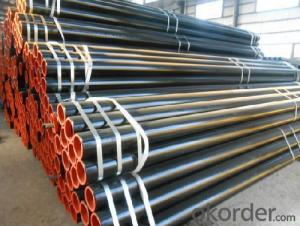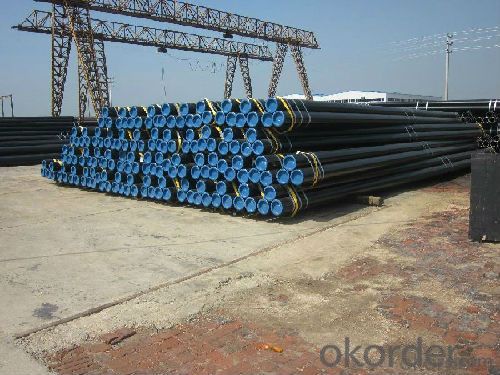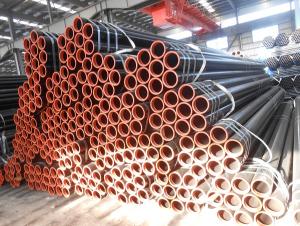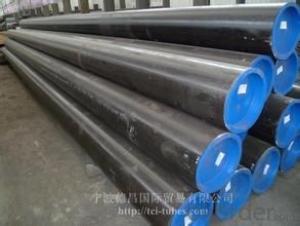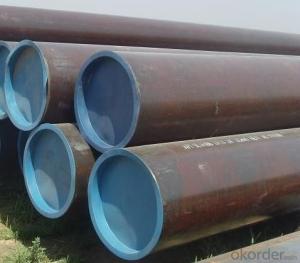seamless stainless steel tubes steel pipe
- Loading Port:
- Shanghai
- Payment Terms:
- TT OR LC
- Min Order Qty:
- 30 kg
- Supply Capability:
- 12000 kg/month
OKorder Service Pledge
OKorder Financial Service
You Might Also Like
Specification
carbon seamless steel pipes are widely used in gas, water and oil, transpotation;constructions;Bridge,highway,windows of model steel door; building materials;fences;heating facilities Fluid Pipe;conduit pipe,scaffolding pipe.etc.
Payment Terms: L/C D/A D/P T/T
Packing and shipment
Packaged in bundles,as per customers' requirements, it can also bepackagesd as beveled ends, typed marking, black painting, plastic caps protection,woven bags packing
For 20" container the max length is 5.8m; For 40" container the max length is 12m. other options are available based on customer requests.
、Main Features of the Seamless Pipe ASTM A106/53:
• High manufacturing accuracy
• High strength
• Small inertia resistance
• Strong heat dissipation ability
• Good visual effect
• Reasonable price
Company Introduction
CNBM International Corporation is the most import and export platform of CNBM group(China National Building Material Group Corporation) ,which is a state-owned enterprise, ranked in 270th of Fortune Global 500 in 2015.
With its advantages, CNBM International are mainly concentrate on Cement, Glass, Iron and Steel, Ceramics industries and devotes herself for supplying high quality series of refractories as well as technical consultancies and logistics solution.
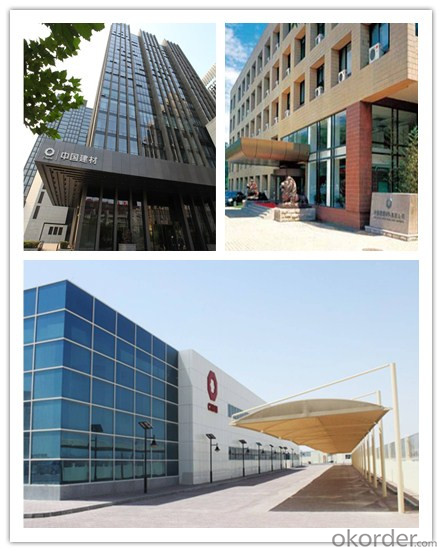

Packaging & Delivery
Packaging Detail | Sea worthy packing /as per customer's packing instruction |
Delivery Detail | 15 ~ 40 days after receiving the deposit |
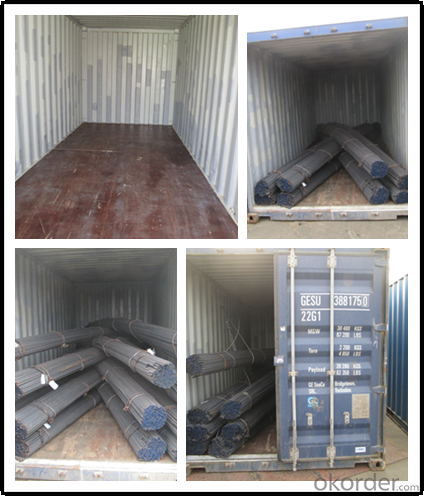
- Q: What is the difference between internal and external coating for steel pipes?
- A protective layer is applied to the inner surface of steel pipes, which is known as internal coating. The main purpose of this coating is to prevent corrosion and enhance resistance against chemicals present in the fluid being transported. Techniques like spraying, brushing, or dipping are commonly used to apply the internal coating, and it can be made of materials such as epoxy, polyurethane, or cement mortar. On the contrary, external coating involves the application of a protective layer on the outer surface of steel pipes. The main objective of this coating is to protect against environmental factors like corrosion, abrasion, and impact. External coatings are usually applied through methods like wrapping or coating with materials such as polyethylene, fusion-bonded epoxy, or asphalt enamel. To summarize, the primary difference between internal and external coating for steel pipes lies in their location and purpose. Internal coatings safeguard the inner surface from corrosion and chemical attacks, while external coatings provide protection against environmental damage on the outer surface. Both types of coatings are essential to ensure the durability and reliability of steel pipes in various applications.
- Q: What is the average lifespan of steel pipes in different applications?
- The average lifespan of steel pipes in different applications can vary depending on various factors such as the quality of the steel, the environment in which the pipes are used, and the maintenance and care they receive. In general, steel pipes used for water supply lines can have an average lifespan of around 50 to 70 years. This is because these pipes are typically made of high-quality steel and are subject to less corrosive environments. However, factors such as water chemistry, soil conditions, and the presence of corrosive substances can significantly influence the lifespan of these pipes. For steel pipes used in industrial applications such as oil and gas pipelines, the average lifespan can range from 20 to 50 years. These pipes are exposed to more aggressive environments, including high temperatures, pressure, and corrosive substances. Regular inspection, maintenance, and corrosion protection measures can help extend their lifespan. In construction applications, steel pipes used for structural purposes can have an average lifespan of 50 to 100 years or more. These pipes are typically designed to withstand heavy loads and are often protected by coatings or insulation to prevent corrosion. It's important to note that these are average lifespans and individual pipes may have shorter or longer lifespans depending on the specific conditions they are exposed to. Regular inspections, maintenance, and timely repairs or replacements when necessary can help ensure the longevity of steel pipes in different applications.
- Q: Will the steel tube dance?
- The steel tube dance tube has a rotating steel tube and a fixed steel tube, so that different types of steel pipe can be chosen according to the type of pipe dance performed by the dancer.
- Q: What are the different methods of joining steel pipes for steam applications?
- The different methods of joining steel pipes for steam applications include welding, threading, flanging, and grooving. Welding involves fusing the pipes together using heat, while threading involves screwing the pipes together using threaded fittings. Flanging involves connecting the pipes by creating a flared or flat surface at the end of each pipe and using bolts to secure them together. Grooving involves creating a groove on the end of each pipe and using a coupling to connect them.
- Q: Can steel pipes be used for underground water supply?
- Yes, steel pipes can be used for underground water supply. However, it is important to consider factors such as corrosion resistance and proper coating to protect the pipes from potential degradation caused by the surrounding soil and water chemistry. Additionally, regular maintenance and inspections are necessary to ensure the longevity and integrity of the steel pipes in underground water supply systems.
- Q: Can steel pipes be used for electrical conduits?
- No, steel pipes are not typically used for electrical conduits as they are conductive and can pose a safety risk. Electrical conduits are usually made of non-conductive materials such as PVC or metal with insulating coatings.
- Q: What place must use galvanized steel pipe to make lighting line?
- Galvanized pipe for pipeline laying construction and transformation of lighting, power, telephone, fire protection system in the engineering (made of galvanized steel), for laying, laying can be laid in the dark, the wall can also be installed on the ceiling.
- Q: What are the common applications of steel pipes?
- Steel pipes have a wide range of common applications in various industries including oil and gas transportation, plumbing systems, structural support in construction, irrigation systems, and industrial processes such as water and wastewater treatment.
- Q: Do steel pipes require maintenance?
- Yes, steel pipes do require maintenance. Regular maintenance is necessary to ensure their proper functioning and longevity. This may involve cleaning, inspecting for any signs of corrosion or damage, and applying protective coatings to prevent rusting. Additionally, periodic maintenance checks and repairs may be needed to address any leaks or structural issues that may arise over time.
- Q: What is the difference between steel pipe and PVC conduit?
- Steel pipe and PVC conduit are both used for different purposes and have different characteristics. One of the main differences between steel pipe and PVC conduit is their material composition. Steel pipe is made of a sturdy and durable material, typically carbon steel or stainless steel. This makes it strong and resistant to impact, making it suitable for heavy-duty applications such as plumbing or structural support. On the other hand, PVC conduit is made of polyvinyl chloride, a type of plastic. PVC is lightweight, flexible, and easy to work with, making it ideal for electrical applications such as protecting and routing electrical wires. Another difference is their resistance to corrosion. Steel pipe is more resistant to corrosion than PVC conduit, especially when coated with protective layers such as zinc or epoxy. This makes steel pipe suitable for outdoor applications, underground installations, or environments with high moisture or corrosive elements. PVC conduit, while generally resistant to moisture and chemicals, may deteriorate over time when exposed to sunlight and can be damaged by certain chemicals. Cost is another factor to consider. Steel pipe is generally more expensive than PVC conduit due to its material and manufacturing process. However, steel pipe's durability and long lifespan make it a cost-effective choice in the long run, especially for applications that require high strength and longevity. PVC conduit, on the other hand, is relatively inexpensive and readily available, making it a more affordable option for many electrical projects. Lastly, installation methods differ between the two. Steel pipe is typically joined together using threaded connections or welded joints, requiring specialized tools and skills. PVC conduit, on the other hand, can be easily cut, assembled, and connected using PVC cement or fittings. This makes PVC conduit a more DIY-friendly option for electrical installations. In summary, the main differences between steel pipe and PVC conduit lie in their material composition, resistance to corrosion, cost, and installation methods. Steel pipe is strong, durable, and corrosion-resistant, making it suitable for heavy-duty applications. PVC conduit, on the other hand, is lightweight, flexible, and affordable, making it ideal for electrical projects.
Send your message to us
seamless stainless steel tubes steel pipe
- Loading Port:
- Shanghai
- Payment Terms:
- TT OR LC
- Min Order Qty:
- 30 kg
- Supply Capability:
- 12000 kg/month
OKorder Service Pledge
OKorder Financial Service
Similar products
Hot products
Hot Searches
Related keywords
